

![[backarrow]](b_arrow.gif) :tilbake til hovedsida..........jump to the English main page:
:tilbake til hovedsida..........jump to the English main page:
![[english-arrow]](c_arrow.gif)


'Boiki'
From the Soviet navy to a Norwegian shore
Skogsøya, North Norway, November 12, 1988. The people at the little hamlet Hjellsand woke up to an unbelievable sight - a Soviet warship grounded near the shore, two hundred meters from the houses. Two days later the newspaper Dagbladet had this story on page nine:
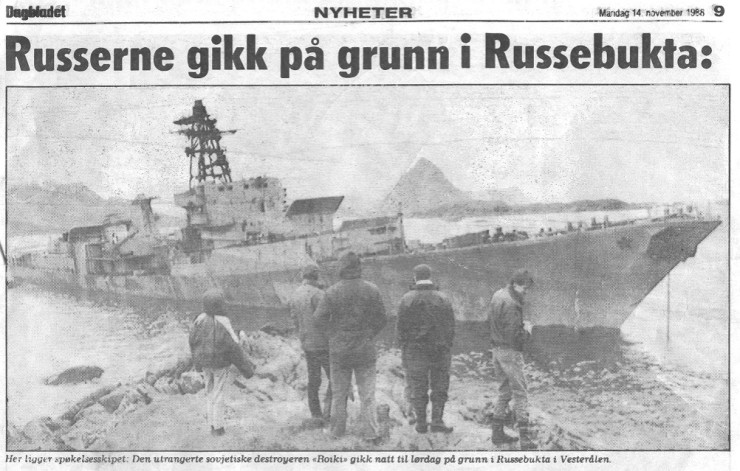
What happened?
Boiki and a sister ship were taken out of service before 1980. In 1988 the two ships started a long journey from the Kola Peninsula, towed by a couple of tugboats. Their destination was a breaker's yard in Spain, and the first part of the journey followed the stormy Norwegian coastline. Outside Vesterålen they met a storm, and the Boiki procession had to seek shelter between Andøya and Langøya. During the night the storm calmed, and in the morning the Norwegian coast guard ordered them out of Norwegian waters. Not enough glasnost yet in 1988 ... After a few hours the storm strengthened again, and suddendly the tugboat crew discovered that the wind pressed the boats backwards. They tried to pick up speed, but then the tugline broke. Boiki drifted away towards land, and ended against a rocky shore at Skogsøya. For a couple of days Boiki stood with its keel planted on the sea bottom and the mast pointing at dark clouds. Then a new storm arrived at the scene and pounded the ship against the rocks. Boiki gave up. It didn't sink, the waters are too shallow. It just turned over and rested on its port side. |
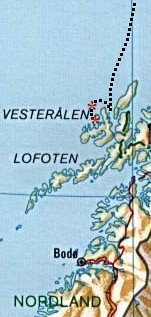 |
Summer 1989:
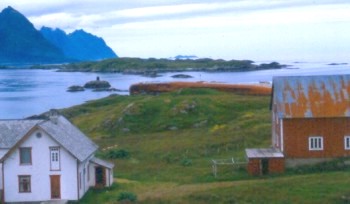 |
This is my home place. Not far from the houses the rusty bottom of Boiki draws an ugly scar across the scenery. On the right side of the photo, above the roof of the barn, we get a peep at the waters where Boiki broke away from the tugboat. At this time the wreck had become a local tourist attraction. Many boats visited the place, but there where other visitors, too - people who went onboard with certain instruments and didn't tell anything afterwards. What did they look for - secrets or contaminations? Perhaps both? |
| Here are some photos showing what once was the top side of Boiki: | |
|---|---|
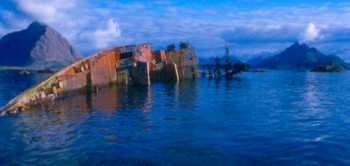 |
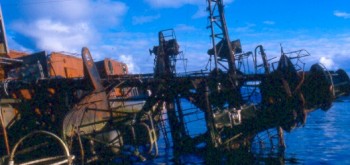 |
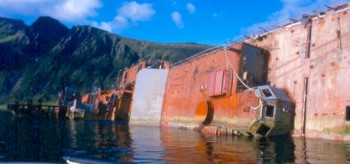 |
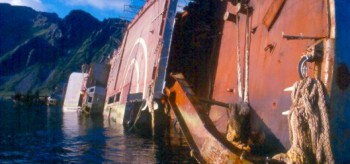 |
What kind of ship was Boiki?
 Boiki was built in the late 1950s. Technically it belonged to the destroyer class. Destroyers are fast warships with offensive as well as defensive capabilities. They can operate independently or together with other warships. A destroyers is made for speed, 36 knots or more, that's why it is given a slender shape. John Steinbeck wrote in 1943: "A destroyer is a lovely ship, probably the nicest fighting ship of all." Maybe so, but it's nevertheless a killer machine. It has several big guns and carries torpedoes, too. The name destroyer is absolutely appropriate. The 145 meter (460 feet) long Boiki was built for nuclear wars, and may have participated in fleet maneuvres around Novaya Semlja, if the rumors are right. It made 38 knots, and had a crew of 120 men. Before it was stripped down it weighed 5,000 metric tons. As it lay at the Skogsøya shore the weight was around 3,000 tons. |
Summer 1994:
After five years Boiki is still there. Soon after it came to Hjellsand a businessman from Oslo bought it from the Spanish indurance company. Some say he paid a hundred dollars, and certainly he hoped to be a rich man from selling all the steel and iron and brass and everything. But how should he remove the wreck? Well, he just wasn't able to do that. And as long as Boiki was his property nothing happened to speak about. |
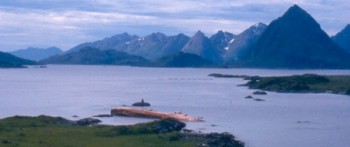 |
Summer 1997:
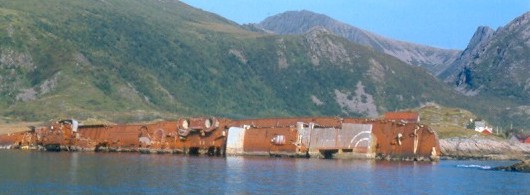 |
Nine winters have done much damage to Boiki. Now the Norwegian government has started to remove old wrecks from the coast, and the local authorities lobby for getting rid of the rusty Russian. But Things Take Time. |
Summer 2001:
The end of Boiki was unglorious. It was cut into pieces by very heavy scissors mounted on a barge (left). Heaps of twisted metal (right) could be seen for some weeks at a storage place before the remnants were carried to a furnace somewhere. (Photos: Fredmund Pettersen) |
|
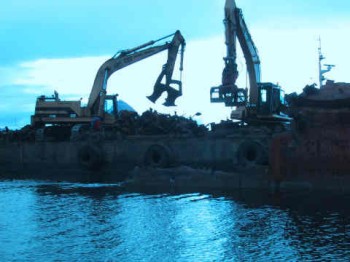 |
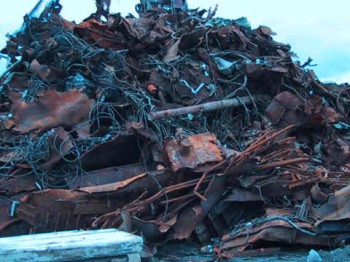 |
Epilogue:
The newspapers noted the curious fact that the Russian warship ended its journey in Russvika - The Russian Bay. Well, given the wind direction it had to follow the same route as Russian timber logs in earlier times! Now Skogsøya is Boiki-free again. The bill? At least two million dollars, but probably far beyond that, if all expences were counted. The lesson? First of all, a stripped Russian destroyer caused limited damage, but what if an oil carrier like "Exxon Valdez" or "Prestige" lands here? And secondly, the traffic along the rocky and stormy Norwegian coast grows and grows ... |
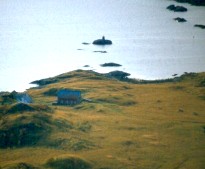 |